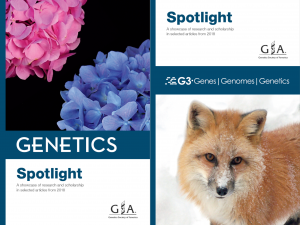Enter your address to receive notifications about new posts to your email.
Articles tagged Genetics Journal
(334 results)
-
Nested CRISPR for cloning-free fluorescent tags
A better way to make endogenous reporters in C. elegans CRISPR systems for gene editing have revolutionized biological research, but the method still has limitations. While it is usually straightforward to delete parts of the genome using CRISPR, large insertions can be a challenge. This has been the case even for the nematode Caenorhabditis elegans,…
-
GSA Journals Spotlight 2018
The GSA Journals, GENETICS and G3: Genes|Genomes|Genetics, are proud to present our annual Spotlight booklets for research published in 2018. Each Spotlight is a showcase of the excellent research and scholarship published over the course of the year, along with a selection of striking images submitted by our authors. Browse the 2018 GENETICS Spotlight. Browse the 2018 G3 Spotlight.
-
“Predicting” the future: how genomic prediction methods anticipated technology
A landmark paper published in GENETICS founded the field of genomic prediction before the requisite technology was available. When a new technology is developed, it can allow scientists to make great strides in addressing longstanding questions. Occasionally, however, researchers think so critically about a knowledge gap in their field that they’re able to propose a…
-
Three GENETICS articles from 2018 recognized with Editors’ Choice Awards
Congratulations to the winners of the Editors’ Choice Awards for outstanding articles published in GENETICS in 2018! The journal’s Editorial Board considered a diverse range of articles, finding many papers worthy of recognition. After much deliberation, they settled on one exceptional article for each of the three award categories: molecular genetics, population genetics, and quantitative genetics. Check out…
-
An ancient regulator of sex development
A Wnt protein involved in the formation of the human ovary plays an important role in female zebrafish sex development. Even though zebrafish are a well-studied research model, how these fish develop into males or females remains rather obscure—in part because the sex of lab strains is not determined by sex chromosomes. Research published…
-
Does Candida grow on trees?
An opportunistic human pathogen makes itself at home on old oaks. At one point or another, most people have played host to the common yeast Candida albicans. Around 40-60% of healthy adults carry around it in their mouth or guts; in immunocompromised people, however, this normally harmless cohabitant becomes a deadly pathogen. Generally thought to…
-
Loaded words
Guest author Amir Teicher discusses how the concept of “genetic load” traces its roots back to eugenic thinking, as described in his recent Perspectives article in GENETICS. The possibilities opened up by advances in genome sequencing have recently spurred discussions on the burden, or cost, that mutations pose to organisms and populations. Does the relaxation…
-
From sequence to centimeters: predicting height from genomes
Machine learning and access to ever-expanding databases improves genomic prediction of human traits. In theory, a scientist could predict your height using just your genome sequence. In practice, though, this is still the stuff of science fiction. It’s not only your genes that affect height—environment also plays a role—but the larger problem is that height…
-
Family tree of 400 million people shows genetics has limited influence on longevity
Study of huge Ancestry.com pedigree suggests assortative mating may have inflated previous estimates of life span heritability. Although long life tends to run in families, genetics has far less influence on life span than previously estimated, according to a new analysis published in GENETICS. Ruby et al. used a data set of over 400 million…
-
What inspired Mendel?
Newly uncovered newspaper articles shed light on Mendel’s motivations. Gregor Mendel is considered by many to be the father of genetics. Yet, because his work was not fully appreciated in its time, little is known about Mendel himself. Primary sources, such as letters he wrote, are rare; only a few dozen pieces of his correspondence…
-
Mitochondria on the mind
Mitochondria cell-autonomously regulate the secretion of neuropeptides in C. elegans. Neurons are hard-working cells that need a lot of energy to do their jobs, so it’s no surprise that they are highly dependent on their mitochondria to function properly. Yet these organelles do much more for cells than simply produce energy. In GENETICS, Zhao et…











